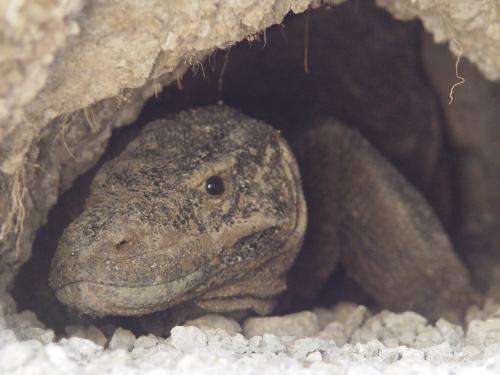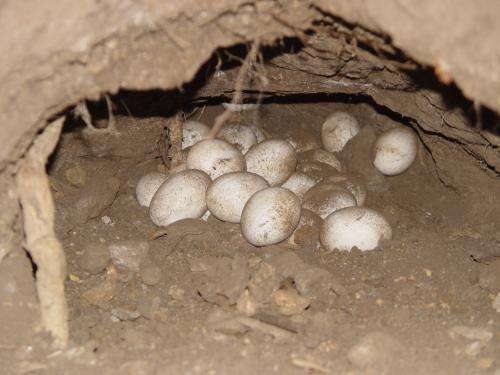Extreme 'housework' cuts the life span of female Komodo Dragons

Extreme 'housework' cuts the life span of female Komodo Dragons
An international team of researchers has found that female Komodo Dragons live half as long as males on average, seemingly due to their physically demanding 'housework' such as building huge nests and guarding eggs for up to six months.
The results provide important information on the endangered lizards' growth rate, lifestyle and population differences, which may help plan conservation efforts.
The Komodo dragon is the world's largest lizard. Their formidable body size enables them to serve as top predators killing water buffalo, deer and wild boar and they have also been known to kill humans.
A research team which included scientists from the University of Melbourne, Australia, Indonesia and Italy studied 400 individual Komodo Dragons for 10 years in eastern Indonesia, their only native habitat. The team then produced a model of the Dragon's growth rate, with results published in the current issue of international journal Plos One.

Males live to around 60 years of age, reaching an average 160 metres in length and 65 kg at adulthood. However their female counterparts were estimated to live an average of 32 years and reach only 120 cm in length, and 22kg.
Dr Tim Jessop from the Department of Zoology at the University of Melbourne was a co-author on the study and said that the team were surprised by the significantly shorter lifespan of the female Komodo Dragon.
"The sex-based difference in size appears to be linked to the enormous amounts of energy females invest in producing eggs, building and guarding their nests. The process can take up to six months during which they essentially fast, losing a lot of weight and body condition, he said.
"Males and females start off at the same size until they reach sexual maturity at around seven years of age. From then on females grow slower, shorter and die younger."
The research team was keen to understand the growth rate of the Komodo Dragons as this critical process can indicate how the species prioritises its energy use in lifestyle and reproductive strategies. The results suggest that females have high energy 'costs' for reproduction resulting in their smaller size, whereas to reproduce successfully, males must keep increasing in size.
The results could have dramatic consequences for the endangered species as early female deaths may be exacerbating competition between males over the remaining females, possibly explaining why males are the world's largest lizards.
"These results may seem odd to humans when the life span between Australian men and women differ by five years. But each species has different strategies to pass on their genes. For example humans invest a lot of energy in few children as raising them is very energy intensive, whereas insects will have hundreds of offspring with no input into their rearing."
Journal information: PLoS ONE
Provided by University of Melbourne


















